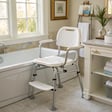Smart rollators are revolutionizing senior mobility. These advanced devices integrate technology to enhance independence and safety, allowing seniors to navigate their environments with confidence. As the population ages, the need for innovative mobility aids has grown significantly, bringing us the smart rollator — an evolution in walking assistance.
The Rise of Smart Rollators
Smart rollators are equipped with features that go beyond traditional models. For instance, they can provide real-time data on the user’s movements, helping to track health metrics. They also include safety mechanisms like automatic braking to prevent falls. The Camino, described as the world's first smart walker, exemplifies this evolution; it boosts, brakes, and detects obstacles, enriching the mobility experience (Camino Mobility).
Additionally, the demographic shift toward an older population has created an urgent demand for devices catering specifically to mobility impairments. The advantages of smart rollators directly address this need, offering functionalities that enhance usability, such as intuitive controls and increased stability, thus improving safety and user experience.
Features That Set Smart Rollators Apart
- Enhanced Safety Technologies:
Smart rollators often come with automatic braking systems that engage under certain conditions, reducing the risk of falls. For example, the CTI One features power brakes and a wireless remote controller, which significantly enhance its safety profile (CTI One).
- User-Friendly Design:
Modern rollators like the Rollz Motion combine walking aid and wheelchair features. This versatility allows users to transition between walking and resting seamlessly, making it suitable for various activities (ROLLZ).
- Smart Connectivity:
Many advanced rollators offer smart features such as connectivity with mobile devices, enabling users to monitor their walking patterns and get reminders for medication or exercise.
How Smart Rollators Improve Quality of Life
The introduction of these devices has considerable implications for seniors. By using smart rollators, older adults can maintain their independence longer. They provide not just physical support but also boost confidence, which can lead to a more active lifestyle and enhanced social interactions.
Key Benefits Include:
- Reduced Risk of Falls: As mentioned, smart braking and stability features help users maintain balance, thus decreasing fall-related incidents.
- Health Monitoring: Some models track heart rate and walking speed, offering valuable insights into the user’s health.
- Encouragement to Stay Active: The ease of use encourages physical activity, helping seniors keep fit and engaged.
The Future of Mobility Tech for Seniors
With ongoing innovation in mobility aids, the future looks bright for smart rollators. Anticipated advancements include greater integration with artificial intelligence and more responsive user interfaces. Research has shown that robotics and intelligent design can enhance elderly mobility, indicating a robust trend in assistive technology (Frontiers).
Manufacturers are focusing on lightweight materials like carbon fiber to make these devices easier to maneuver. This could make a significant difference in the day-to-day lives of mobility-impaired seniors, allowing them to enjoy increased freedom and comfort.
Why Embrace Smart Rollators?
If you or someone you know is exploring mobility options, smart rollators represent an exciting development. The combination of technology and design seeks to address the unique challenges faced by seniors today. They’re not merely tools; they can serve as companions in mobility, facilitating a fulfilling lifestyle.
Common Question: Do Smart Rollators Work for All Seniors?
Yes, smart rollators can significantly benefit most seniors, particularly those who experience mobility challenges. Some models are designed for different levels of mobility, offering features that adapt to individual needs. It's best to discuss these options with a healthcare provider to find the most suitable choice.
Smart rollators represent more than just mobility solutions; they are pivotal in empowering seniors to navigate their world. As technology continues to evolve, these devices will likely only improve, fostering greater independence for older adults.
Considerations for Future Developments
As we look towards 2025 and beyond, the horizon for walking aids is promising. Integration of advanced technologies, increased personalization options, and improvements in comfort and usability will be crucial. The industry shows great potential for further innovation, promising to keep our seniors connected and mobile.
In summary, smart rollators mark a significant leap in assistive devices. They not only promise enhanced mobility but also enrich the quality of life for seniors. As these technologies evolve, they will be instrumental in supporting the independence and well-being of older adults everywhere.
Disclaimer: This content is for informational purposes only and not a substitute for professional medical advice. Always consult with a healthcare provider for personalized guidance.
Tags

About Elliott Greenway the Author
Elliott Greenway is a seasoned environmentalist and avid cyclist with over a decade of experience promoting sustainable transport solutions. His expertise in eco-friendly cycling has inspired countless individuals to take up cycling as a means to reduce their carbon footprint and embrace a healthier lifestyle.
Recommended Articles
2025 BMW X3 Raises the Bar for Compact Luxury Crossovers
Discover the 2025 BMW X3, a compact luxury crossover that combines performance, design, and advanced technology to set a new standard in its class.
2025 Hyundai Ioniq 6 Is the Sleek Electric Sedan of the Future
Discover the 2025 Hyundai Ioniq 6, an electric sedan with sleek design, advanced technology, and impressive range for modern drivers.
This Mobility Device Is Replacing Walkers in 2025
Explore how the Camino smart walker is revolutionizing mobility for seniors in 2025, enhancing independence and safety with cutting-edge technology.
A Spoon of This Oil Goodbye Stiff Joints
Discover how a daily spoonful of olive oil can ease joint stiffness and improve mobility. Simple dietary changes can lead to significant benefits.
What Caregivers Say About Today’s Newer Shower Chairs
Discover how modern shower chairs enhance safety and accessibility for caregivers, featuring adjustable designs and innovative materials.




